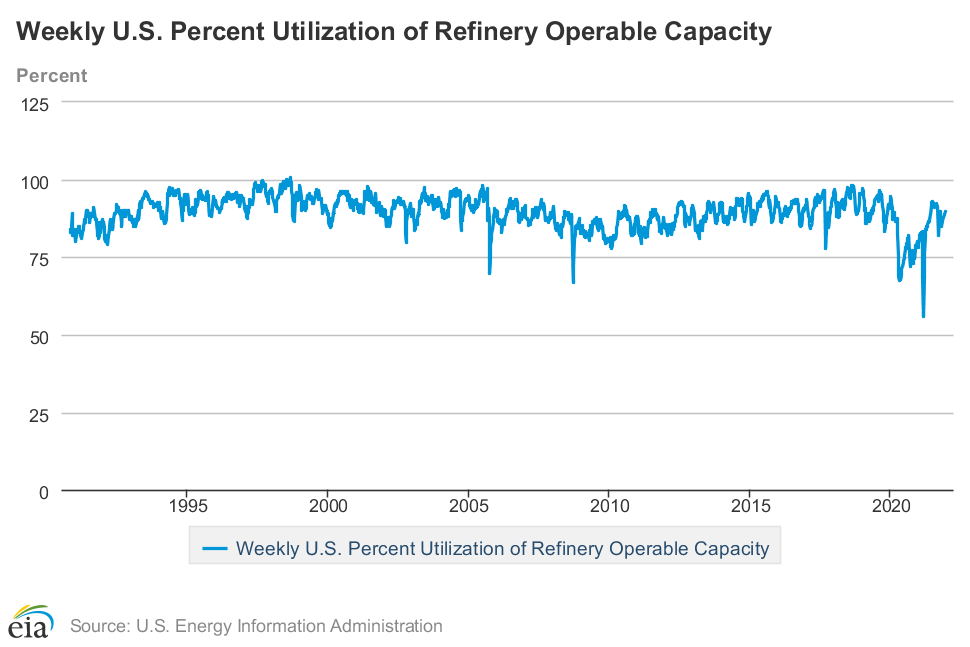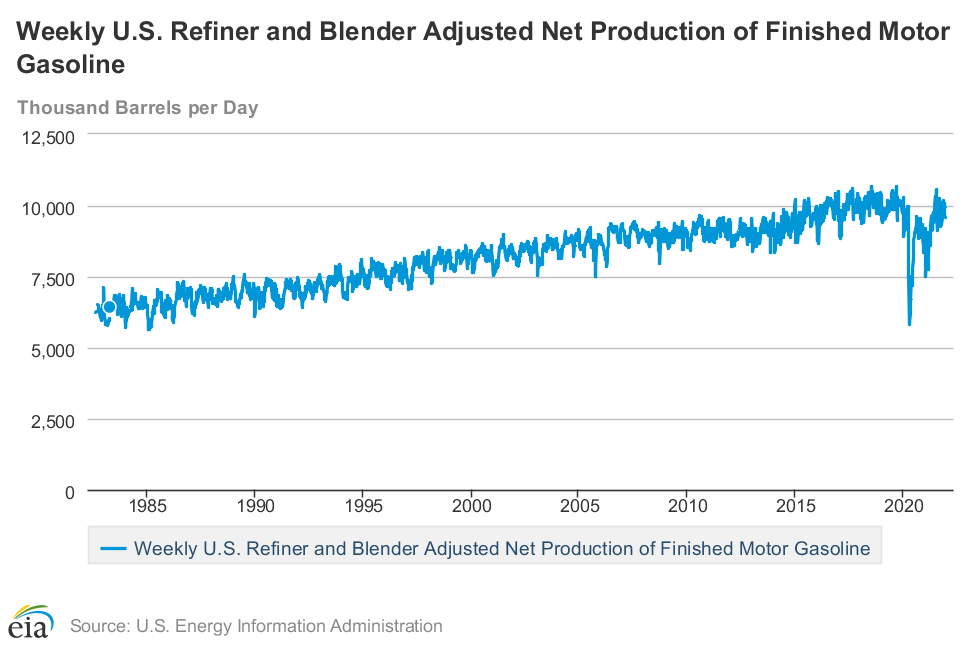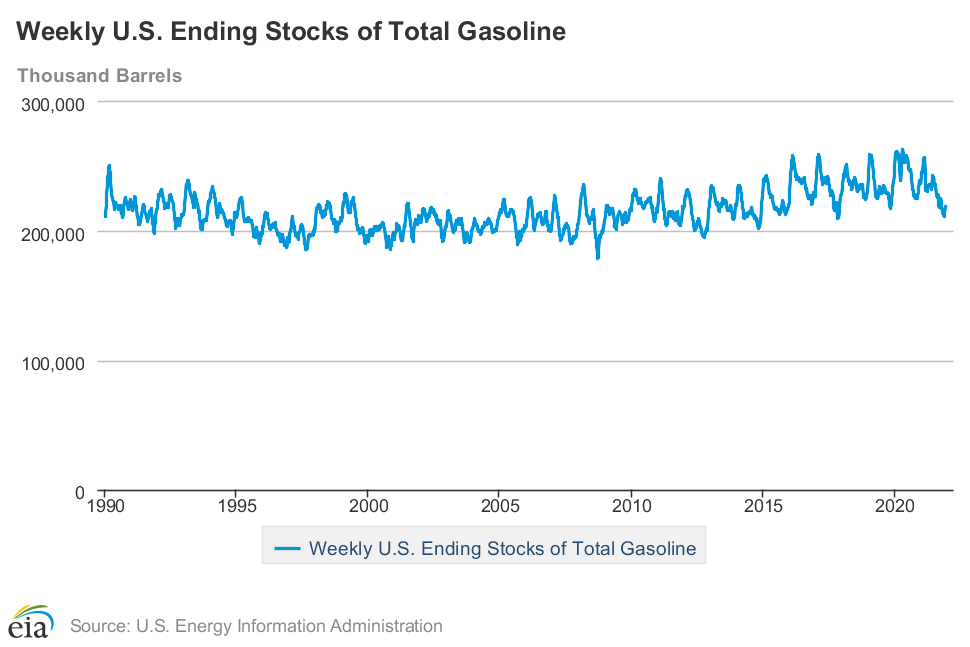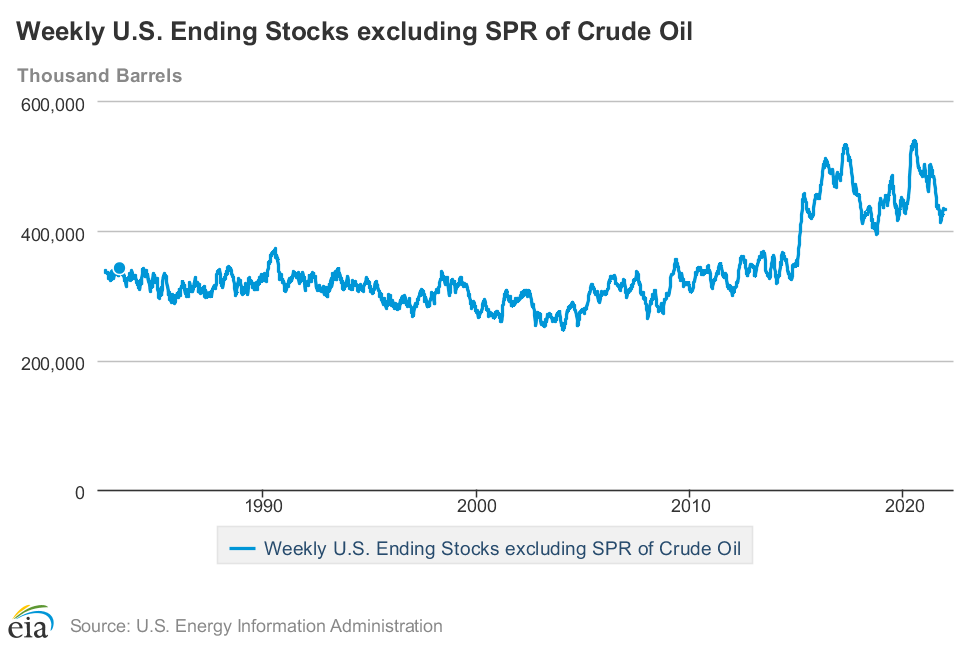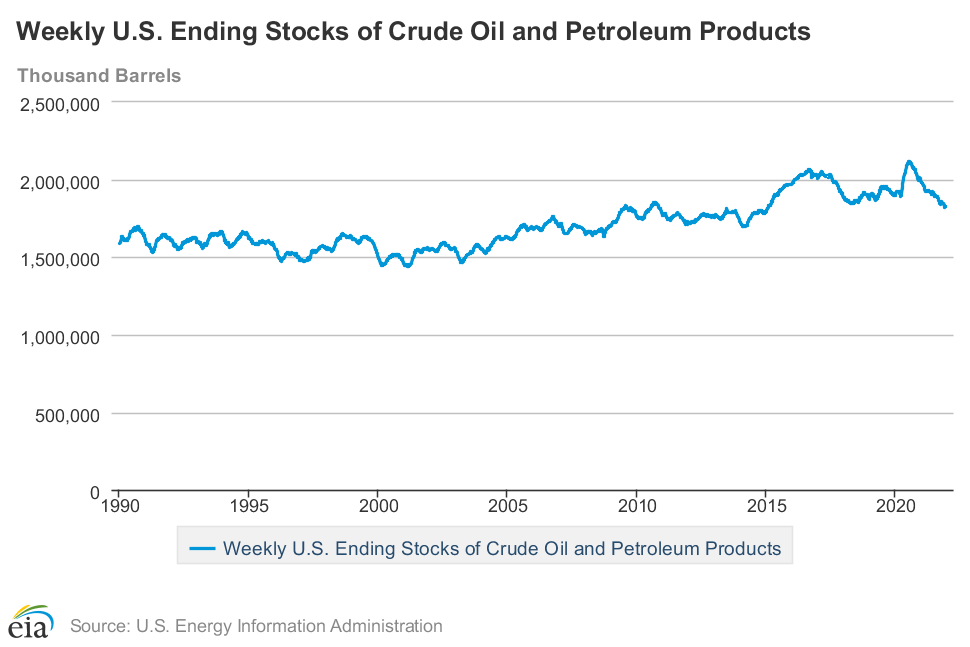Oil rebounds on Omicron optimism; SPR at another 18 1/2 year low as sales to Asian refiners begin, Focus of Fracking, RJS Not really much news this week; gasoline & distillate inventories continue to rebound from the lows, no big moves on prices or much else; the headline is almost contrived . . . the “sales to Asian refiners” came from an oil blogger who said we sold SPR oil to China and India. That information hasn’t been released yet. Biden’s oil reserve sale attracts foreign bidders –The Biden administration’s efforts to lower energy costs takes a step forward Monday… Although winning bids won’t be announced until Dec. 14, at least two international oil refiners have expressed interested in the swap.. Oil reserves released by Biden
Topics:
run75441 considers the following as important: Focus on Fracking, Hot Topics, oil production, RJS, US/Global Economics
This could be interesting, too:
NewDealdemocrat writes JOLTS revisions from Yesterday’s Report
Joel Eissenberg writes No Invading Allies Act
Joel Eissenberg writes How Tesla makes money
NewDealdemocrat writes January JOLTS report: monthly increases, but significant downward revisions to 2024
Oil rebounds on Omicron optimism; SPR at another 18 1/2 year low as sales to Asian refiners begin, Focus of Fracking, RJS
Not really much news this week; gasoline & distillate inventories continue to rebound from the lows, no big moves on prices or much else; the headline is almost contrived . . . the “sales to Asian refiners” came from an oil blogger who said we sold SPR oil to China and India. That information hasn’t been released yet.
Biden’s oil reserve sale attracts foreign bidders –The Biden administration’s efforts to lower energy costs takes a step forward Monday… Although winning bids won’t be announced until Dec. 14, at least two international oil refiners have expressed interested in the swap..
Oil reserves released by Biden expected to primarily go to China…
US Strategic Petroleum Reserve at an 18 1/2 Year Low as sales to Asian refiners begin . . .
The Latest US Oil Supply and Disposition Data from the EIA
US oil data from the US Energy Information Administration for the week ending December 3rd showed that despite a sizable decrease in our oil exports, we needed to pull oil out of our stored commercial crude supplies for the fourth time in eleven weeks and for the twenty-fourth time in the past thirty-six weeks . . . our imports of crude oil fell by an average of 105,000 barrels per day to an average of 6,499,000 barrels per day, after rising by an average of 168,000 barrels per day during the prior week, while our exports of crude oil fell by an average of 434,000 barrels per day to an average of 2,270,000 barrels per day during the week, which together meant that our effective trade in oil worked out to a net import average of 4,229,000 barrels of per day during the week ending December 3rd, 329,000 more barrels per day than the net of our imports minus our exports during the prior week . . . over the same period, production of crude oil from US wells was reportedly 100,000 barrels per day higher at 11,700,000 barrels per day, and hence our daily supply of oil from the net of our international trade in oil and from domestic well production appears to have totaled an average of 15,929,000 barrels per day during the cited reporting week…
Meanwhile, US oil refineries reported they were processing an average of 15,785,000 barrels of crude per day during the week ending December 3rd, an average of 153,000 more barrels per day than the amount of oil that refineries processed during the prior week, while over the same period the EIA’s surveys indicated that a net of 276,000 barrels of oil per day were being pulled out the supplies of oil stored in the US . . . so based on that reported & estimated data, this week’s crude oil figures from the EIA appear to indicate that our total working supply of oil from net imports, from storage, and from oilfield production was 420,000 barrels per day more than what our oil refineries reported they used during the week . . . to account for that disparity between the apparent supply of oil and the apparent disposition of it, the EIA just plunked a (-420,000) barrel per day figure onto line 13 of the weekly U.S. Petroleum Balance Sheet to make the reported data for the daily supply of oil and the consumption of it balance out, essentially a balance sheet fudge factor that they label in their footnotes as “unaccounted for crude oil”, thus suggesting there must have been a error or omission of that magnitude in this week’s oil supply & demand figures that we have just transcribed . . . however, since most everyone treats these weekly EIA reports as gospel and since these figures often drive oil pricing, and hence decisions to drill or complete oil wells, we’ll continue to report this data just as it’s published, and just as it’s watched & believed to be reasonably accurate by most everyone in the industry . . . (for more on how this weekly oil data is gathered, and the possible reasons for that “unaccounted for” oil, see this EIA explainer)….
This week’s 276,000 barrel per day net decrease in our crude oil inventories came as 34,000 barrels per day were pulled out of our commercially available stocks of crude oil, while 241,000 barrels per day of oil were pulled out of our Strategic Petroleum Reserve, possibly still part of an emergency loan of oil to Exxon in the wake of hurricane Ida . . . including the drawdowns from the Strategic Petroleum Reserve under such emergency programs, a total of 52,161,000 barrels per day have been removed from the Strategic Petroleum Reserve for a series of other “emergencies” over the past 16 months, and as a result the amount of oil in our Strategic Petroleum Reserve has fallen to an 18 1/2 year low of 600,867,000 barrels per day, as repeated tapping of our emergency supplies for political expediency or to “pay for” other programs have already drained those supplies over the past dozen years…with the BIden administration’s announcement two weeks ago that another 50 million barrels of oil will be released to incentivize continued use of American gas guzzlers, we have initiated weekly coverage of the SPR storage status on this blog…
Further details from the weekly Petroleum Status Report (pdf) indicate that the 4 week average of our oil imports rose to an average of 6,432,000 barrels per day last week, which was 15.4% more than the 5,590,000 barrel per day average that we were importing over the same four-week period last year . . . this week’s crude oil production was reported to be 100,000 barrels per day higher at 11,700,000 barrels per day because the EIA’s rounded estimate of the output from wells in the lower 48 states was 100,000 barrels per day higher at 11,200,000 barrels per day, while Alaska’s oil production to was unchanged at 454,000 barrels per day and added 500,000 barrels per day to the reported rounded national production total . . . US crude oil production had hit a pre-pandemic record high of 13,100,000 barrels per day during the week ending March 13th 2020, so this week’s reported oil production figure was still 10.7% below that of our pre-pandemic production peak, but 38.8% above the interim low of 8,428,000 barrels per day that US oil production had fallen to during the last week of June of 2016…
US oil refineries were operating at 89.8% of their capacity while using those 15,785,000 barrels of crude per day during the week ending December 3rd, up from 88.8% of capacity the prior week, but still a bit lower than normal utilization for early December refinery operations… the 15,785,000 barrels per day of oil that were refined this week were 9.3% more barrels than the 14,436,000 barrels of crude that were being processed daily during the pandemic impacted week ending December 4th of last year, but 4.9% less than the 16,597,000 barrels of crude that were being processed daily during the week ending December 6th, 2019, when US refineries were operating at what was then also a less than seasonal 90.6% of capacity…
Even with the increase in oil being refined this week, the gasoline output from our refineries was still a bit lower, decreasing by 86,000 barrels per day to9,563,000 barrels per day during the week ending December 3rd, after our gasoline output had decreased by 450,000 barrels per day over the prior week . . . this week’s gasoline production was still 14.7% more than the 8,340,000 barrels of gasoline that were being produced daily over the same week of last year, but 1.9% less than the gasoline production of 9,753,000 barrels per day during the week ending December 6th, 2019….on the other hand, our refineries’ production of distillate fuels (diesel fuel and heat oil) increased by 45,000 barrels per day to 4,917,000 barrels per day, after our distillates output had increased by 88,000 barrels per day over the prior week…with that increase, our distillates output was 5.3% more than the 4,917,000 barrels of distillates that were being produced daily during the week ending December 4th, 2020, but still 5.9% less than the 5,228,000 barrels of distillates that were being produced daily during the week ending December 6th, 2019..
Even with the big drop in our gasoline production, our supplies of gasoline in storage at the end of the week rose for the second time in nine weeks, and for the fourteenth time in thirty-three weeks, increasing by 3,882,000 to 219,304,000 barrels during the week ending December 3rd, after our gasoline inventories had increased by 4,029,000 barrels over the prior week . . . our gasoline supplies increased again this week even though the amount of gasoline supplied to US users increased by 167,000 barrels per day to 8,963,000 barrels per day, and even as our imports of gasoline fell by 85,000 barrels per day to 558,000 barrels per day, while our exports of gasoline fell by 95,000 barrels per day to 792,000 barrels per day…and even after this week’s big inventory increase, our gasoline supplies were still 7.8% lower than last December 4th’s gasoline inventories of 237,859,000 barrels, and about 5% below the five year average of our gasoline supplies for this time of the year…
With the increase in our distillates production, our supplies of distillate fuels increased for the fourth time in fifteen weeks and for the 12th time in 35 weeks, rising by 2,733,000 barrels to 126,610,000 barrels during the week ending December 3rd, after our distillates supplies had increased by 2,160,000 barrels during the prior week….our distillates supplies rose this week because the amount of distillates supplied to US markets, an indicator of our domestic demand, fell by 631,000 barrels per day to 3,578,000 barrels per day, even as our exports of distillatesjumped by 630,000 barrels per day to 1,218,000 barrels per day, while our imports of distillates rose by 35,000 barrels per day to 269,000 barrels per day . . . but after twenty-four inventory decreases over the past thirty-five weeks, our distillate supplies at the end of the week were still 16.2% below the 151,092,000 barrels of distillates that we had in storage on December 4th, 2020, and about 7% below the five year average of distillates stocks for this time of the year…
Meanwhile, despite the drop in our oil exports, our commercial supplies of crude oil in storage fell for the 18th time in the past twenty-eight-weeks and for the 34th time in the past year, decreasing by 241,000 barrels over the week, from 433,111,000 barrels on November 26th to 432,870,000 barrels on December 3rd, after our commercial crude supplies had decreased by 909,000 barrels over the prior week . . . after this week’s decrease, our commercial crude oil inventories slipped to around 7% below the most recent five-year average of crude oil supplies for this time of year, but were still 25% above the average of our crude oil stocks as of the second weekend of December over the 5 years at the beginning of the past decade, with the disparity between those comparisons arising because it wasn’t until early 2015 that our oil inventories first topped 400 million barrels . . . since our crude oil inventories had jumped to record highs during the Covid lockdowns of last spring and remained elevated for most of the year after that, our commercial crude oil supplies as of this December 3rd were 14.0% less than the 503,231,000 barrels of oil we had in commercial storage on December 4th of 2020, and are now 3.4% less than the 447,918,000 barrels of oil that we had in storage on December 6th of 2019, and 2.1% less than the 441,954,000 barrels of oil we had in commercial storage on December 7th of 2018…
Finally, with our inventory of crude oil and our supplies of all products made from oil all near multi year lows, we are continuing to track the total of all U.S. Stocks of Crude Oil and Petroleum Products, including those in the SPR….the EIA’s data shows that total oil and oil product inventories, including those in the Strategic Petroleum Reserve and those held by the oil industry, rose by 2,511,000 barrels this week, from 1,824,711,000 barrels on November 26th 1,827,222,000 barrels on December 3rd, and is now up by 4,830,000 barrels, or by 0.3%,from the 82 month low of two weeks ago...


